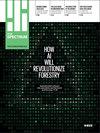Supercollider Engineers Are Trying to Break Physics: If They Do, We May Finally Understand Dark Matter
IF 2.4
4区 工程技术
Q2 ENGINEERING, ELECTRICAL & ELECTRONIC
引用次数: 0
Abstract
In Particle Physics, the smallest problems often require the biggest solutions. • Along the border of France and Switzerland, around a hundred meters underneath the countryside, protons speed through a 27-kilometer riung-about seven times the length of the landy 500 circuit-until they crash into protons going in the opposite direction. These particle pileups produce a petabyte of data every second, the most interesting of which is poured into data centers, accessible to thousands of physicists worldwide. The Large Hadron Collider (LHC), arguably the largest experiment ever engineered, is needed to probe the universe,s smallest constituents. In 2012, two teams at the LHC discovered the elusive Higgs boson, the particle whose existence confirmed 50-year-old theories about the origins of mass. It was a scientific triumph that led to a Nobel Prize and worldwide plaudits. Since then, experiments at the LHC have focused on better understanding how the newfound Higgs fits inti the Standard Model, particle physicists' best theoretical description of matter and forces-minus gravity. “The Standard Model is beautiful,” says Victoria Martin, an experimental physicist at the University of Edinburgh. “Because it's so precise, all the little niggles stand out.”超级对撞机工程师正试图打破物理学:如果他们做到了,我们可能最终了解暗物质
在粒子物理学中,最小的问题往往需要最大的解决方案。•沿着法国和瑞士的边界,在乡村地下大约100米的地方,质子在一个27公里长的环路中快速穿行——大约是陆地500环路长度的7倍——直到它们撞向相反方向的质子。这些粒子堆每秒产生1拍字节的数据,其中最有趣的数据被注入数据中心,供全球数千名物理学家访问。大型强子对撞机(LHC)可以说是有史以来最大的实验,它需要探测宇宙中最小的组成部分。2012年,大型强子对撞机的两个团队发现了难以捉摸的希格斯玻色子,这种粒子的存在证实了50年前关于质量起源的理论。这是一个科学上的胜利,为他赢得了诺贝尔奖和全世界的喝彩。从那时起,大型强子对撞机的实验就集中在更好地理解新发现的希格斯粒子如何符合标准模型——粒子物理学家对物质和力的最佳理论描述——负引力。“标准模型是美丽的,”爱丁堡大学的实验物理学家维多利亚·马丁说。“因为它非常精确,所有的小细节都很突出。”
本文章由计算机程序翻译,如有差异,请以英文原文为准。
求助全文
约1分钟内获得全文
求助全文
来源期刊

IEEE Spectrum
工程技术-工程:电子与电气
CiteScore
2.50
自引率
0.00%
发文量
254
审稿时长
4-8 weeks
期刊介绍:
IEEE Spectrum Magazine, the flagship publication of the IEEE, explores the development, applications and implications of new technologies. It anticipates trends in engineering, science, and technology, and provides a forum for understanding, discussion and leadership in these areas.
IEEE Spectrum is the world''s leading engineering and scientific magazine. Read by over 300,000 engineers worldwide, Spectrum provides international coverage of all technical issues and advances in computers, communications, and electronics. Written in clear, concise language for the non-specialist, Spectrum''s high editorial standards and worldwide resources ensure technical accuracy and state-of-the-art relevance.
 求助内容:
求助内容: 应助结果提醒方式:
应助结果提醒方式:


